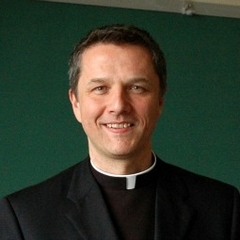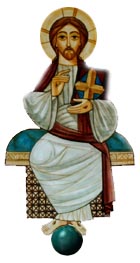Many people are plagued with FOMO. Do you know what FOMO is? Think: Fear of missing out.
Post-Christian America: what does it look like, why?
Bouncing around in Catholic religious orders for some time is the notion that one can be a member of the Jesuits or the Sisters of Mercy and “go beyond Jesus and the Church.” I can remember hearing from a Jesuit whom I respected in the early 1990s that he was a “post-Christian Jesuit.” I wondered how a member of the Society of Jesus, a son of Saint Ignatius, could be post-Christian. The former Dominican Father Matthew Fox tried the same line of thinking. In fact, he’s neither a Catholic nor a Catholic priest and a professed member of the Order of Preachers as he’s gone to the Episcopal Church and now some kind of new ager. Christ is optional for him. Not long ago a religious sister who teaches at CTU said that the sisters in the USA can go beyond Jesus. So the recent crisis in faith in religious orders reflects a deeper divide in Christian faith in the rest of society.
Saint Bernard, 900 years since entering Cîteaux
Nearly 900 years ago Bernard of Fontaine-lès-Dijon led
a group of young Burgundian noblemen, to the Abbey of Cîteaux in 1112 or 1113. The fledgling
new monastery got a burst of new life and from there set the world ablaze with
what became the Cistercian charism.
North America, paying particular attention to the intention of young men and women entering the
monastic life under the gaze of Saint Bernard. Beginning today until a year from now, the Cistercians are observing a Year of Saint Bernard. Let’s join them in knowing more about this pivotal saint and monk.
the New Monastery at Cîteaux our fathers followed the poor Christ into the
desert. Thus they lived the Gospel, by rediscovering the Rule of Saint Benedict
in its purity.
attractive and appealing to others, in the joy of the Holy Spirit.
we today, after their example, may live our charism deeply in a spirit of
peace, unity, humility, and above all, in the charity which surpasses all other
gifts.
life, in the service of the Church’s mission, in a world often forgetful of
You.
enthusiastic and generative spirit of the founders. And in all of our needs may
we always turn to Our Lady whom Bernard called the Star of the Sea.
Father, from whom we have already received so much, grant us again your
blessing that our communities may grow in numbers, but above all in grace and
in wisdom, to your glory, who are blessed for ever and ever. Amen.
Benedictine abbots to meet in Rome
 The Office of the Abbot Primate announces…
The Office of the Abbot Primate announces…
Almost 300 monastics will gather in Rome, 17-25 September 2012, for the international Congress of Benedictine Abbots and Conventual Priors at the Primatial Abbey of St. Anselm on the Aventine Hill. Preceding the Congress, new monastic superiors will participate, 15-16 September 2012, in an orientation program. 25 representatives from Communio Internationalis Benedictinarum (CIB), an association of Benedictine sisters and nuns, will also attend the Congress. The Abbot Primate has invited ecumenical guests from the Orthodox and Reformed traditions.
Benedictine monasteries, and Fr. Michael Casey OCSO offering a paper on autonomy in Benedictine life. In addition, a wide range of workshops will address current topics in monastic life; such as, Benedictine identity, stress and burnout, associate membership programs, management of monasteries, individualism in the monastery, relationship with Benedictine women, new forms of Benedictine presence in society, ecumenism, the paschal mystery in the sacred liturgy, new directions for inter-monastic dialogue, new structures for AIM, the changing role of the Athenæum S. Anselmo,the sexual abuse crisis, the role of the abbot, communio in the confederation,and the formation of “traditionalist” candidates.
The assembled abbots and conventual priors will have the opportunity to visit in pilgrimage the monasteries of Subiaco, Montecassino, Norcia, and Camaldoli, which is celebrating its 1000th anniversary this year. Nearly half of the 250 abbots and conventual priors will reside in the Collegio S. Anselmo, with the others, including CIB representatives and ecumenical guests, housed in area religious houses and hotels.
The Sex Abuse Crisis in Ireland, a review
In March, 60 Minutes ran a story on the archbishop of Dublin, Diarmuid Martin, and the response to the sex abuse crisis in Ireland. On August 19, 60 Minutes is running the story again. It is a slow news time of the year, but I think the story is worth seeing again.
Nellie Gray, Pro-Life “mother” died
Last weekend Nellie Gray, 88, the “Mother of the Pro-Life” movement in the USA died at her Washington, DC home. She was the voice of the marginal in the USA. The annual March for Life was founded by Nellie 39 years ago. She worked to shed light on the evil of abortion which has claimed 55 million lives. The Mass of Christian Burial was celebrated for the repose of Nellie Gray on the Solemnity of the Assumption.
Cardinal Sean Patrick O’Malley, OFM, Cap, said of Nellie Gray:
Having received
news of Nellie Gray’s death, I wish to express my sincere condolences and
prayers for her family and for all who came to know and love her in the
Pro-Life Movement. Her love for life and her dedication to protecting the
unborn, the most vulnerable among us, have inspired countless generations of
Catholics and non-Catholics alike, and we will miss her tremendously.
Nellie
Gray will be remembered as the Joan of Arc of the Gospel of Life. The
architects of the pro-abortion movement in the United States thought that the
opposition would go away, but close to 40 years later the issue is still very
much alive, thanks in part to the annual March for Life and because of people
like Nellie who are committed to the culture of life. Having participated in
every single March for Life since its inception, I have witnessed firsthand her
advocacy and dedication. I was honored by her presence in Boston in 2009, when
during the Boston Catholic Women’s Conference we conferred upon her the Culture
of Life Award.
Her death is a great loss for both our Church and our Country,
but her life has left a meaningful and lasting impression upon the hearts of
those who knew her and upon the many hearts of those whose lives she saved. We
will keep Nellie Gray and all those who mourn her death in our prayers. We ask
God to grant her eternal rest and peace, and we give thanks to Him for the gift
of her life.
Our Lady of Life, pray for Nellie Gray, and for us.
Catholic University Looks East
 Salvation comes from the East! You’ve heard that before, no? If not, then it is news you ought to welcome, not just because an Eastern Catholic priest, Father Mark Morozowich is the new Dean of the School of Theology at the Catholic University of America.
Salvation comes from the East! You’ve heard that before, no? If not, then it is news you ought to welcome, not just because an Eastern Catholic priest, Father Mark Morozowich is the new Dean of the School of Theology at the Catholic University of America.
Oriental Orthodox Churches face elections
 The Coptic and Ethiopic Churches face the elections of new popes in the coming weeks. Pope Shenouda III died in March 2012 after serving as pope of his Church for 40 years. Yesterday, the patriarch of the Ethiopic Church Abune Paulos died at the age of 76. Shenouda had health issues and Paolus apparently died of a heart attack (there’s some controversy on the reason for the death).
The Coptic and Ethiopic Churches face the elections of new popes in the coming weeks. Pope Shenouda III died in March 2012 after serving as pope of his Church for 40 years. Yesterday, the patriarch of the Ethiopic Church Abune Paulos died at the age of 76. Shenouda had health issues and Paolus apparently died of a heart attack (there’s some controversy on the reason for the death).
Cardinal Dolan explains his invites to Al Smith Dinner
There’s been a lot of posturing –let alone misinformation– about the recent revelation that the Cardinal of New York, Timothy M. Dolan, invited the US President to the famed Al Smith Dinner. He wants to be inclusive, open to dialogue, and helpful in trying to inform politicos about Catholic teaching on life and public service. Civility is Dolan’s hope.
Assumption of the Blessed Virgin Mary
 “those He justified, He also glorified” (Rom
“those He justified, He also glorified” (Rom
8:30)
of Mary from this world to the next. The Eastern Christians call today’s feast
the “Dormition,” the falling asleep of the Theotokos and the assumption to
heaven. In the West, we refer to this feast as the Assumption. That Mary,
without decay of the human, was called to heaven body and soul, by God.




